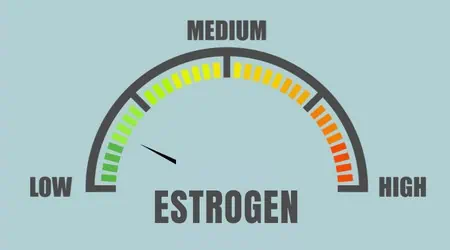 If you’re a woman of reproductive age, making sufficient estrogen is important for mood, bones, muscles, and metabolism.
If you’re a woman of reproductive age, making sufficient estrogen is important for mood, bones, muscles, and metabolism.
Signs you’re making enough estrogen include the presence of cervical fluid and regular ovulation.
Signs you’re not making enough estrogen include a lack of periods and vaginal dryness.
🎈
Blood tests for estradiol
Your main estrogen is estradiol, and it fluctuates throughout the cycle.
Early in the cycle (day 2 or 3), estradiol should be very low, typically below 50 pg/mL (180 pmol/L).
A few days before ovulation (around day 10 of a 28-day ovulatory cycle), peak estradiol should be 200 to 400 pg/mL (700 to 1400 pmol/L).
A natural ovulatory cycle is how you make estrogen
If your estradiol is low, your first question is, “Are you ovulating regularly?”. Because if you are ovulating, you know you’ve made enough estradiol — otherwise, you would not have been able to achieve ovulation.
If you’re not ovulating, your next question is, “Can you still ovulate, or are you in menopause?
Menopause (or, if you’re younger than 45, primary ovarian insufficiency) is diagnosed by two FSH readings (taken at least a month apart) higher than 40 IU/L. So, if two FSH readings are higher than 40 IU/L, you’re in menopause; see below. If your FSH is less than 40 IU/L, you’re not in menopause and can still ovulate. That’s true even if you’ve had a partial hysterectomy (uterus removed). If you have ovaries, you can ovulate, at least until menopause.
Figure out why you’re not ovulating.
For example, are you on the combined contraceptive pill? If so, you’re making no estradiol, so your blood level will be very low. Instead, you have the pill’s synthetic estrogen (ethinylestradiol), which is similar to estradiol but not identical. That’s why being on the pill can cause vaginal dryness.
Other possible reasons you’re not ovulating include:
- you have a type of PCOS,
- you’re undereating,
- you have a problem with gluten,
- you have high prolactin,
- and more
For a full discussion of obstacles to ovulation, see Chapter 7 of my book Period Repair Manual.
Once you identify your obstacle to ovulation, correct that obstacle and your estradiol will rise dramatically. That’s all you need to do.
What about menopause?
With menopause, your ovaries naturally make far less estradiol than they used to, so your estradiol will be low on a blood test. You will, however, continue to make some estrogen inside every cell, and since menopause is a natural life phase, your body can adapt to the lower (mostly intracellular) estrogen.
See my book Hormone Repair Manual for a full discussion of perimenopause and menopause, including the option to take body-identical estradiol.
What about phytoestrogens?
If you’re of reproductive age (i.e., not in menopause), phytoestrogens like soy or flaxseed generally have a beneficial anti-estrogen effect. They will not raise estrogen.
After menopause, phytoestrogens can stimulate estrogen receptors and have a mildly pro-estrogen effect.

